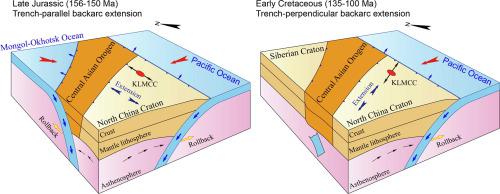Gondwana Research ( IF 7.2 ) Pub Date : 2021-04-17 , DOI: 10.1016/j.gr.2021.04.002 Shaoze Lin , Chenglong Xie , Biwei Xiang , Wei Wang , Cheng Liu , Hailong Li , Peng Li

|
The driving force of backarc extension remains a subject of debate. In this study, we investigate the Kalaqin metamorphic core complex (MCC) in the eastern North China Craton, to determine the driving mechanism of backarc extension related to subduction of the Paleo–Pacific Plate. The MCC records two phases of extensional structures. D1 structures include the NE–SW–striking Louzidian–Dachengzi and Jinshan–Meilin detachment shear zones on both sides of the core complex. These zones originally constituted a single NE–dipping, low–angle, normal–sense detachment shear zone that records deformation temperatures of 500–600 °C. The shear zone seprarted rifted upper crust from locally deformed middle–lower crust. Together, the D1 structures constitute a Cordillera–type MCC associated with magmatism. The MCC was then overprinted by a second phase of extension (D2) that produced a NE–SW–trending horst between rift basins. The interior of the horst was deformed by early normal shear belts and later normal faults, all striking NE–SW. Our U–Pb zricon dating results from deformed and undeformed igneous rocks, together with previous geochronolical data, constrain D1 at 156–150 Ma (Late Jurassic) and D2 at 135–100 Ma (Early Cretaceous). Kinematic and fault–slip data show an evolution from D1 trench–parallel to D2 trench–perpendicular extension with respect to subduction of the Paleo–Pacific Plate. The D1 trench–parallel, NE–SW extension is considered to have resulted from both west–northwestward subduction of the Paleo–Pacific Plate and southward subduction of the Mongol–Okhotsk Oceanic lithosphere, whereas the D2 trench–perpendicular, NW–SE extension took place after closure of the Mongol–Okhotsk Ocean and is ascribed to the subduction of the Paleo–Pacific Plate only.
中文翻译:

从trench沟平行向back垂直后弧延伸的突然转变:华北克拉通东部卡拉沁变质岩心复合体的证据
Backarc扩展的驱动力仍然是一个争论的话题。在这项研究中,我们调查了华北克拉通东部的卡拉钦变质岩心复合体(MCC),以确定与古太平洋板块俯冲有关的弧后伸展的驱动机制。MCC记录了扩展结构的两个阶段。D 1结构包括位于核心复合体两侧的NE–SW–娄子店—大成子和金山—Meilin脱离剪切带。这些区域最初构成了一个NE浸渍,低角度,法线感测的分离剪切带,记录了500-600°C的变形温度。剪切带将裂谷的上地壳与局部变形的中下地壳分开。一起,D 1结构构成与岩浆作用相关的科迪勒拉型MCC。然后,MCC被第二个扩展阶段(D 2)叠印,在裂谷盆地之间产生了NE–SW趋势趋势。早期的正常剪切带和后期的正常断层使霍斯特内部变形,所有这些震撼都发生在NE–SW上。我们的U–Pb zricon测年结果来自变形和未变形的火成岩,再加上先前的年代学数据,将D 1限制在156–150 Ma(侏罗纪晚期),D 2限制在135–100 Ma(早白垩世)。运动学和断层滑动数据表明,相对于古太平洋板块的俯冲作用,D 1沟槽平行于D 2沟槽垂直延伸。D 1认为与海沟平行的NE-SW延伸是古太平洋板块的西-西北向俯冲和蒙古-鄂霍次克大洋岩石圈南向俯冲的结果,而D 2沟-垂直,NW-SE的延伸发生了蒙古-鄂霍次克海关闭后,仅归因于古太平洋板块的俯冲。











































 京公网安备 11010802027423号
京公网安备 11010802027423号